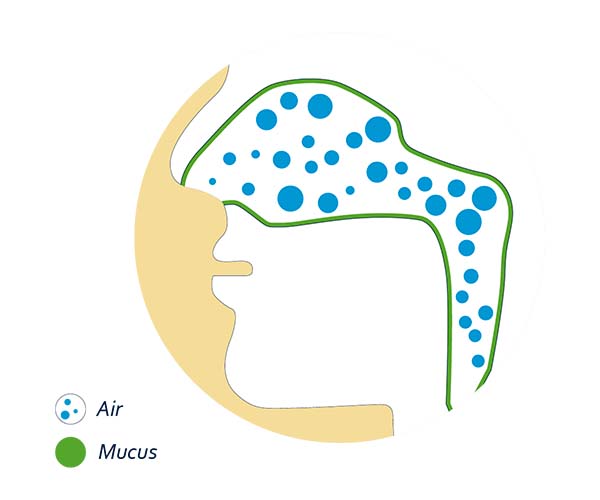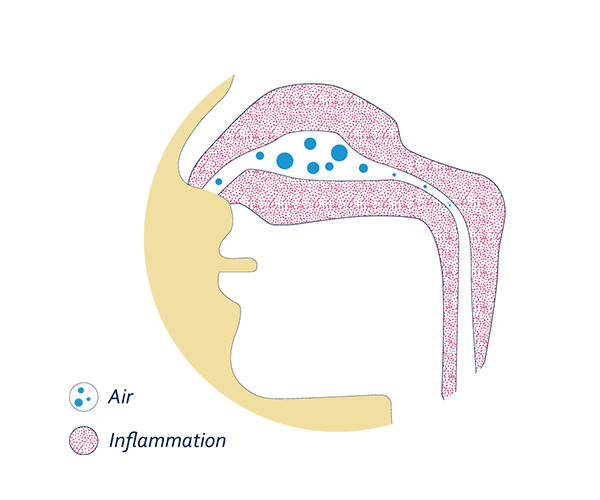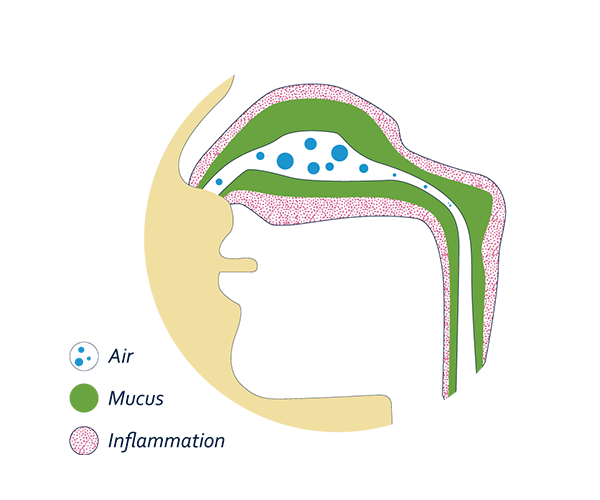Common cold/Rhinitis/Rhinopharyngitis
The common cold, also called rhinitis or rhinopharyngitis, is a minor viral infection that frequently affects young children but also adults.
It can be recognized by its inflammation of the nose (blocked nose, runny nose) and throat (pain and irritation), watery eyes, sometimes headaches and/or a little fever. A cough may also appear in children.

More commonly known as rhinitis or simply a cold, rhinopharyngitis is a benign viral infection caused particularly by the rhinoviruses and coronaviruses.(1) It affects the upper airways (nose, throat and sinuses) and can affect the lungs and ears too.
It is one of the most common winter ailments: an adult can catch a cold up to 4 times a year.(2) Babies and young children are also particularly susceptible to colds. Children under 7 years of age may catch up to 6 to 8 colds a year, predominantly in the autumn and winter.(3)
Common cold or Rhinopharyngitis affects the mucous membranes in the nasal cavity (located at the back of the nose) and throat (back of the mouth).
- Because it is situated at the top of the airways, nasal mucosa is exposed daily to our environment: pollution, dust, pathogens (viruses or bacteria), etc. It thus acts as an essential filter for removing these particles, by secreting a liquid that moistens the inhaled air: nasal mucosa is an effective natural barrier protecting our airways and controlling the quality of the air we breathe in.

A thin layer of mucus covers its surface, forming a protective, hydrating film which traps external particles.
Nasal mucosa: the nose’s first line of defence
- When the mucosa becomes inflamed (caused by a virus, bacterium or allergen), it no longer acts as a filter. It swells up, becomes irritated and produces mucus in excess, reducing the air flow in the nostrils. This obstructs the nasal cavity, leading to the sensation of a blocked nose.

The mucous membranes become swollen by inflammation, and the blood vessels dilate

The mucous membranes are obstructed by too much mucus in reaction to a virus
- Located at the back of the throat, the pharyngeal mucosa is exposed daily to potential stressors: food, viruses, bacteria, pollution and climate change (cold weather in winter for example). In the same way as nasal mucosa, pharyngeal mucosa must keep its defences up daily to minimise the risks of inflammation. If it does become inflamed, this can lead to a sore throat.
Rhinopharyngitis (the common cold) is spread either by miniscule droplets suspended in the air, through contact with a contaminated object (door handles, tissues, etc.) or by direct contact: saliva, hands, etc.(4)
Symptoms appear one to three days after exposure to the virus.(4) The first symptoms affect the general health of a sufferer, who may experience slight fatigue or chills. These are followed by sneezing, nasal obstruction (blocked nose) and rhinorrhoea (runny nose). The runny fluid is translucent at first and gradually becomes thicker after a few days. A cough may occur, especially in children. There is usually little or no fever.(2)
Other symptoms such as headaches or ear discomfort (blocked or sore ears) may be experienced.
Rhinopharyngitis symptoms can vary in length and intensity depending on the person. It can thus develop over a variable period, from 5 to 20 days, but usually heals spontaneously in 7 to 10 days, without any medication. (2)
Whilst common cold symptoms are not serious, they can still be a nuisance and cause discomfort in our daily lives.
Common colds can occur more easily in people with :
- Weakened immune systems, following a bout of stress or fatigue
- Iron deficiency
- A chronic condition such as cystic fibrosis, affecting the immune system
- An allergic background
- Gastro-oesophageal reflux disease (GORD) which can lead to an inflammation of the pharyngeal mucosa
Repeated contact, whether in a professional or personal setting, leading to increased viral circulation.
1 https://www.vidal.fr/maladies/chez-les-enfants/rhinopharyngite-enfant/traitement-prevention.html (consulté le 28 juin 2022)
2 https://www.ameli.fr/loire-atlantique/assure/sante/themes/rhinopharyngite-adulte/symptomes (accessed on June 28, 2022)
3 Vidal.fr – Recommandations – Rhinopharyngite aiguë de l’enfant (accessed on June 28, 2022)
4 https://www.le-guide-sante.org/actualites/medecine/rhinopharyngite-causes-symptomes-traitements (accessed on June 28, 2022)

